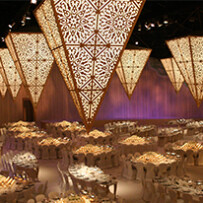Exhibit Lighting | Cost-Conscious Strategies

This article is packed with practical and effective ideas for saving money on exhibit lighting. Written by Jeff Rudner, president of Exhibit Lighting Group Inc. in West Hills, California, the strategies are included in a response to an EXHIBITOR Q &A question about how to control costs on exhibit lighting design.
Rudner distills his advice down to five budget-wise exhibit-lighting strategies:
- Bring your lighting-design partner into the exhibit design discussion early on. Giving your lighting designer a seat at the table during exhibit-design talks means you’ll get input about what lighting will work with your proposed design and where there could be problems. The exhibit lighting designer can also provide ongoing cost estimates, and respond to any layout changes with cost-effective suggestions.
- Ask for cost-effective lighting design ideas before finalizing the exhibit. Rudner says that in some cases, simply moving an exhibit component forward or backward a couple of feet can make the difference between hanging a light directly from a venue structure, and adding complex, expensive rigging for your truss system. A lighting design pro can also tell you whether the exhibit layout is lighting-design friendly in the first place.
- Make sure the lighting designers and other subcontractors collaborate on the installation and dismantle (I&D) plan. With all teams involved, I&D can be done in a logical, sequential order that prevents budget waste.
- Don’t piecemeal the exhibit lighting plan. Enlisting your own staff or using the exhibit house to put together a lighting plan may seem like a way to save money, but you’re likely to spend more in the long run. Lighting designers have experience in energy-saving options, and can often use their own equipment or leverage professional relationships to help you obtain equipment cost effectively.
- Prioritize your game plan. Determine up front which lighting elements are most important and which ones you could do without if circumstances require a change. The best way to create a plan, according to Rudner, is to prioritize the lighting elements into critical, necessary and ancillary lighting. He goes on to describe each of the elements for illuminating your exhibit.
These and other tips from Rudner could help ensure that your lighting-design dollars are well spent.
Read the full article.

 Combining Old and New :: Altec Lansing
Combining Old and New :: Altec Lansing Customizable Entrances :: Life Technologies
Customizable Entrances :: Life Technologies Frankfurt, Germany :: Luminus Devices
Frankfurt, Germany :: Luminus Devices